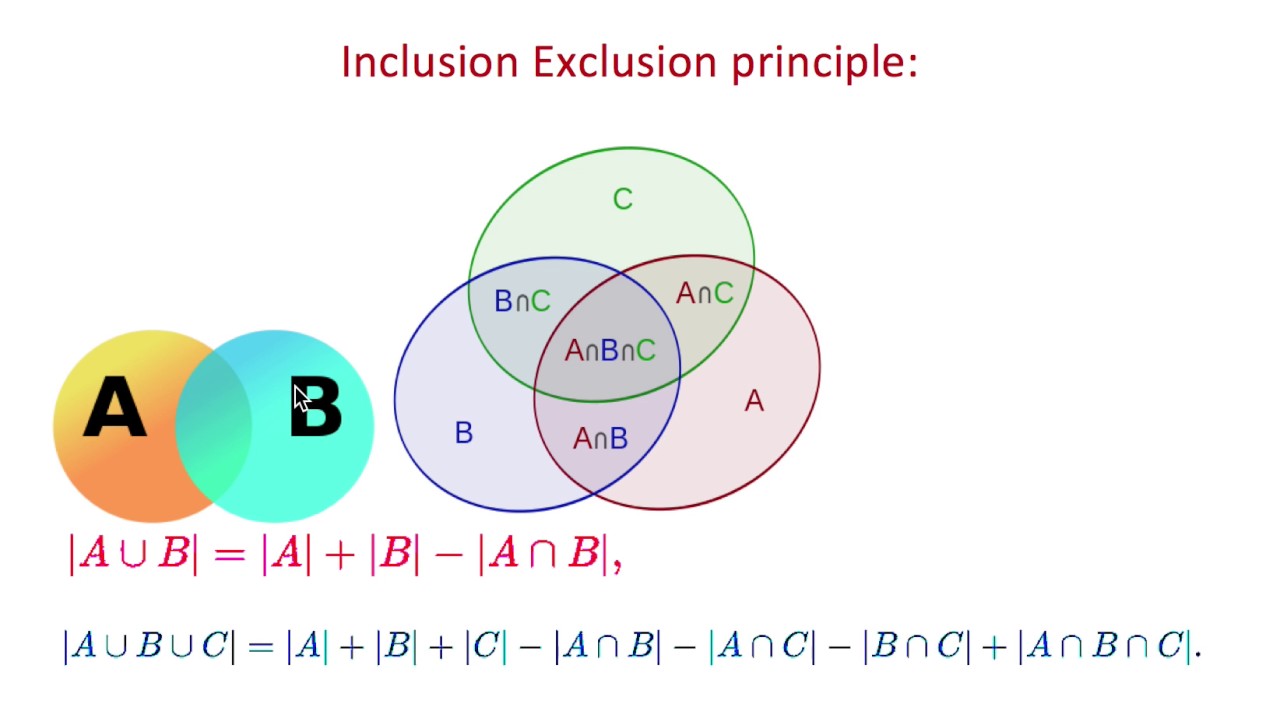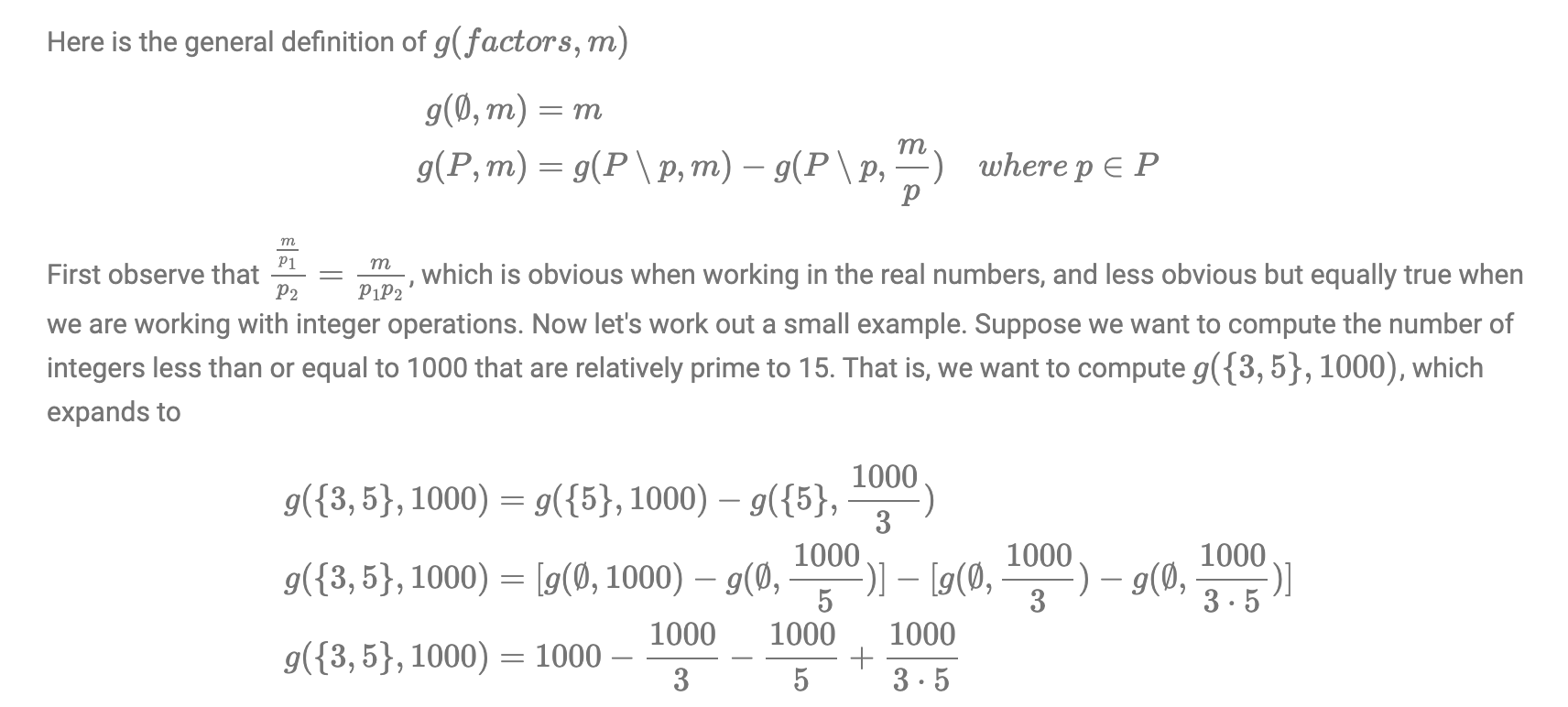Notes
bool prime(int n) {
if (n < 2) return false;
if (n <= 3) return true;
if (!(n % 2) || !(n % 3)) return false;
for (int i = 5; i * i <= n; i += 6)
if (!(n % i) || !(n % (i + 2))) return false;
return true;
}
Inclusion exclusion priniciple https://dyingdown.github.io/2019/08/15/Inclusion-Exclusion-Principle/ and http://www.ryanhmckenna.com/2016/04/counting-coprime-pairs-using-inclusion.html and http://laurentmazare.github.io/2014/09/14/counting-coprime-pairs
The principle of inclusion exclusion is a very powerful idea that can be used to solve alot of problems that arise in combinatorics and number theory.


Let's say we want to count the number of positive integers k that are less than or equal to r and relatively prime to n. Task: Given two numbers n and r, count the number of integers in the interval [1;r] that are relatively prime to n (their greatest common divisor is 1).
Using set theoretic notation, week seek to find the cardinality of the set {p ∣ p ∈ {1,2,…,r}, gcd(n, p) = 1} where gcd is the greatest common divisor function.
We will count f(n, r) the complement of task(the number of integers which are not relatively prime to n) and then exclude them from r. For this we will use inclusion exclusion priniciple, let's denote the prime factors of n as pᵢ (1 ≤ i ≤ k), If we create sets for numbers divisible by each pᵢ then

int solve (int n, int r) {
vector<int> p; // prime divisors of n
for (int i=2; i*i<=n; ++i)
if (n % i == 0) {
p.push_back (i);
while (n % i == 0)
n /= i;
}
if (n > 1)
p.push_back (n);
int sum = 0;
for (int msk=1; msk<(1<<p.size()); ++msk) {
int mult = 1, bits = 0;
for (int i=0; i<(int)p.size(); ++i)
if (msk & (1<<i)) {
++bits;
mult *= p[i];
}
int cur = r / mult; // number of divisors in [1:r]
if (bits % 2 == 1)
sum += cur; // inclusion
else
sum -= cur; // exclusion
}
return r - sum;
}
Let's define g(primeFactors(n), m) = m - f(n, m) then

This expansion is exactly equivalent to the formula from the inclusion exclusion method, although it's much easier to implement. This recursive function works because once the set of prime factors have been exhausted, every combination of primes have been produced, and the associated term in the inclusion exclusion formula has the correct sign for the contribution.
In number theory, Euler's totient function counts the positive integers up to a given integer n that are relatively prime to n.
Application of Inclusion exclusion priniciple
Given integers L and L , R ( L ≤ R ) , find the number of pairs ( x , y ) of integers satisfying all of the conditions below: L ≤ x , y ≤ R Let g be the greatest common divisor of x and y . Then, the following holds
L ≤ x,y ≤ R(1 ≤ L ≤ R ≤ 10⁶)- Let
gbe the greatest common divisor ofxandy. Theng ≠ 1, x/g ≠ 1 and y/g ≠ 1.
https://atcoder.jp/contests/abc206/tasks/abc206_e
Solution:
(i, i)doesn't satifiy the given conditions asgcd(i, i) = iandi/i = 1. So we will calculate(x, y)such thatx < yand multiply this by2to get the final answer.- If
x < ythen obviouslyy/gcd(x,y) ≠ 1asgcd(x, y) ≤ x. So we only need to worry aboutg ≠ 1andx/g ≠ 1conditions. - First consider the case where
g ≠ 1i.e count the number of integer pairs such that two integers are relatively prime. From this we subtract the case wherex/g = 1 - To count the number of pairs of coprime integers x, y. We can use inclusion-exclusion prinicple. Specifically, it can be counted as follows.
- For every integer
k( 2 ≤ k ≤ R ) that does not have two or more same prime factors, count the number of multiples ofk, obtained by⌊R/k⌋ − ⌊(L − 1)/k⌋, which we will denote A . - Then, if k has odd number of prime factors, we add combination C(A, 2) to the answer; otherwise we subtract C(A, 2) from the answer. The number of distinct prime factors in k can be precalculated in the same way to the Eratosthenes' sieve.
- For every integer
- To count the pairs that satisfy
x/g == 1andg ≠ 1, we find the multiples ofg = x
#include<bits/stdc++.h>
using namespace std;
int main(){
long long l,r;
cin >> l >> r;
long long res=0;
vector<int> cnt(1048576,0);
for(long long i=2;i<=r;i++){
if(cnt[i]!=0){continue;}
for(long long j=i;j<=r;j+=i){cnt[j]++;}
// exclude numbers having two or more same prime factors
for(long long j=i*i;j<=r;j+=i*i){cnt[j]=-1000000007;}
}
for(long long i=2;i<=r;i++){
if(cnt[i]<0){continue;} // i has more than one same prime factor
long long cc=(r/i)-((l-1)/i);
if(cnt[i]%2){res+=(cc*(cc-1))/2;} // inclusion
else{res-=(cc*(cc-1))/2;} // exclusion
}
// exclude tha pairs where (x=g, y)
for(long long i=max(2ll,l);i<=r;i++){res-=(r/i-1);}
cout << 2*res << '\n';
return 0;
}
Another solution: https://atcoder.jp/contests/abc206/submissions/23577424
gcd(x, y) is a multiple of k if and only if both x and y are multiples of k . The number of multiples of k between L and R (inclusive) are Xk := ⌊R/k⌋ − ⌊(L − 1)/k⌋, so the number of pairs L ≤ x , y ≤ R such that gcd(x, y) is a multiple of k is Xₖ². gcd(x, y) is exactly k if and only if “gcd(x, y) is a multiple of k , but not 2k, 3k, … .” Therefore, these can be computed in the decreasing order of k . The complexity is O(R log R), where the bottleneck is finding the number of pairs such that gcd(x, y) = k.
typedef long long ll;
typedef pair<int, int> P;
ll c[1000010];
ll c1[1000010];
int main()
{
ll l, r;
cin>>l>>r;
for(ll d=2; d<=r; d++){
for(ll x=d; x<=r; x+=d){
if(x<l) continue;
c[d]++;
}
}
ll ans=0;
for(ll d=r; d>=2; d--){
c1[d]=c[d]*c[d];
for(ll x=2*d; x<=r; x+=d) c1[d]-=c1[x];
ans+=c1[d];
if(d>=l) ans-=2*c[d]-1;
}
cout<<ans<<endl;
return 0;
}
https://codeforces.com/blog/entry/54090 and https://codeforces.com/blog/entry/53925
TODO: https://open.kattis.com/problems/coprimeintegers
TODO: https://github.com/miguelAlessandro/library/tree/master/Number%20theory